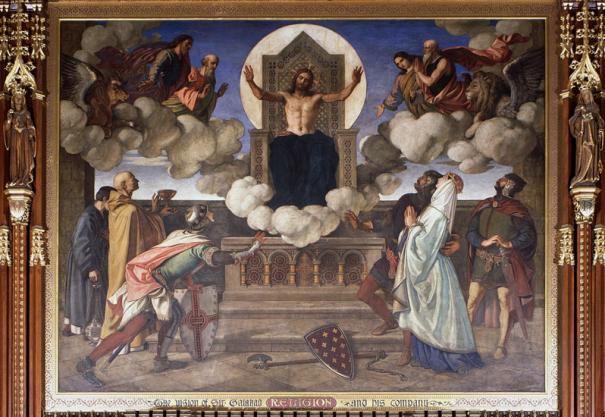About the Artist
William Dyce
Born: Aberdeen, 19 September 1806
Died: London, 15 February 1864
Nationality: Scottish

Religion: the Vision of Sir Galahad and His Company
William Dyce, 1851.
Collection
Palace of Westminster, London
Documentation
Marcia Pointon notes Dyce’s Renaissance homage:
“The total pictorial concept of Religion approximated to a Florentine altar-piece (the style of the throne accentuating this) in which Sir Galahad and company occupy the position of donors. The fresco is charged with dramatic force but, in sacrificing the proximity of Christ to the knights as described by Malory, Dyce lost an equally important element. The intimacy of the occasion is what is remarkable in the textual version, Christ descending, becoming real, approaching humanity. Even a middle-of-the-road Anglican like [poet Alfred] Tennyson ignored this quality and described Galahad’s vision vicariously in a terrifying futuristic landscape. It is scarcely surprising then that Dyce rejected normalcy in Mallory’s description.”
“The over-all composition of Religion derives from Raphael’s Disputa either directly, or possibly through the intermediary influence of Overbeck’s Triumph of Religion in the Arts, the drawing for which was Prince Albert’s Christmas gift to the Queen [Victoria] in 1847. There are also echoes of the Raphael cartoons as, for example, in the figure of Galahad so strongly reminiscent of the semi-crouching figures in the foreground of The Sacrifice at Lystra and The Death of Ananias. The Raphael cartoons would have been accessible to William [Dyce] at Hampton Court. When in Italy, in 1845, he visited a recently discovered fresco attributed to Raphael who, it seems, embodied his idea of perfection: ‘something between Ghirlandaio and Pinturicchio – possessing the solidity of the former and the transparency of the latter’.”
Marcia Pointon, William Dyce 1806-1864. A Critical Biography (Oxford, UK: Clarendon Press, 1979), 117 & 118.